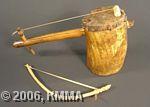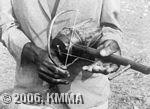


The iningidi is a stringed instrument (chordophone) with a single string and is classified as a fiddle. The resonator, which is usually made of a cow’s horn but is sometimes wooden or can even be a metal tin, is cylindrical (13-16 cm high with a diameter of 10-12 cm, narrowing to 8-9 cm). A piece of cowhide is stretched over the top of the hollow soundbox and fixed using either nails or the thorny spines of the acacia. The neck of the iningidi emerges from the side of the soundbox. Consisting of a straight wooden stick between 35 and 50 cm in length, it is inserted through the soundbox so that the string can be tied around the short protruding end. The neck itself measures 25 to 40 cm. At the top of the neck a hole is bored 3 cm from the end, into which a tuning pin is inserted vertically. The other end of the string is secured to this pin in such a way that the string can be wound by turning the pin around its axis. This enables the player to obtain the correct fundamental note. The string itself is usually made from plant material and runs over the soundbox via a bridge, which lifts it clear of the soundbox. Finally there is an arched bow that is made from a thin curved branch and vegetable fibre string.
To play the instrument, the neck is held in the palm of the left hand so that the string can be stopped using the second phalanx of the index, middle and ring fingers. A total of four notes can therefore be produced with an interval of a second between each one, giving a range of a fourth. The soundbox of the iningidi is held against the stomach and the instrument is bowed with the right hand.
A singer accompanies himself on the iningidi and usually plays solo. The iningidi is not commonly played by older men or by women. The musician has his own repertoire, which may, however, be based on – or contain elements of – that of other performers. The lyrics concern everyday life in the hills and sometimes also political events.
The iningidi originates from Uganda and was only introduced to Rwanda at the beginning of the twentieth century. Some sources mention 1910, while others claim it appeared later, after 1940. One thing is certain: the iningidi is not part of the traditional organological patrimony of Rwanda.
Only the Hutu play the iningidi, using it to accompany popular songs, indirimbo, about ordinary incidents and about life in the hills.
An iningidi with two strings was once found, where one of the strings was used as a kind of ostinato bourdon (bass line) and the other played the melody.
Some distinctive characteristics of the music include the instrumental introduction and the strophic structure, as well as the unisonant sound of instrument and song. As a result of this unisonance, the rhythm of the music has been influenced by the spoken language, which uses short and long syllables.
For more information consult the following publications edited by the RMCA:
© KMMA/Jos GANSEMANS